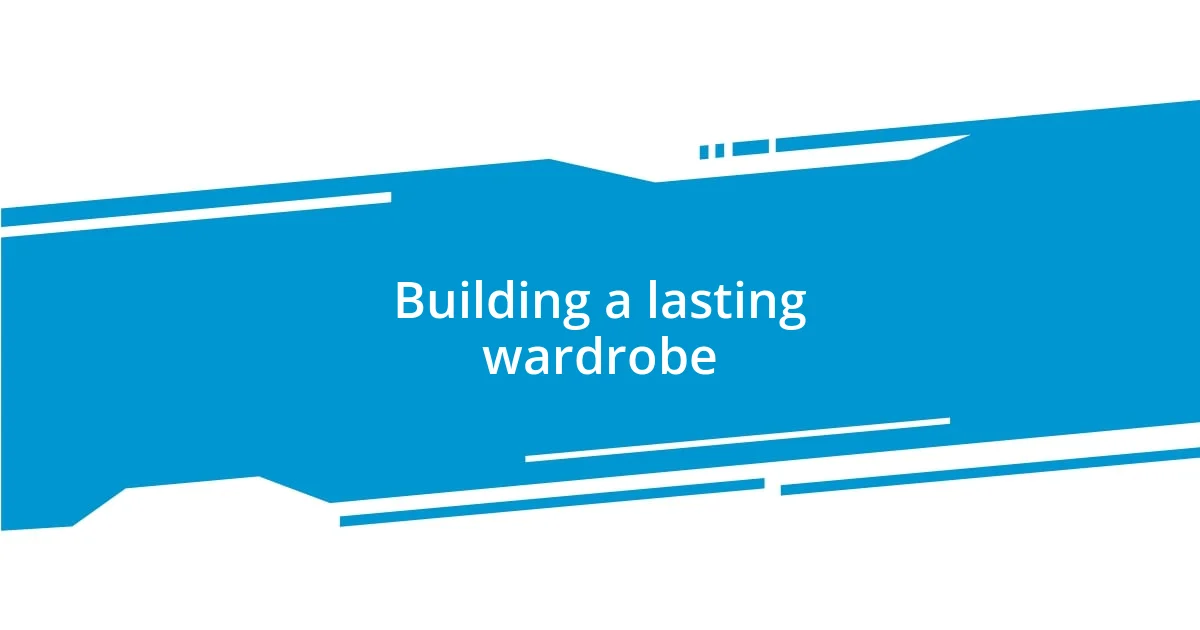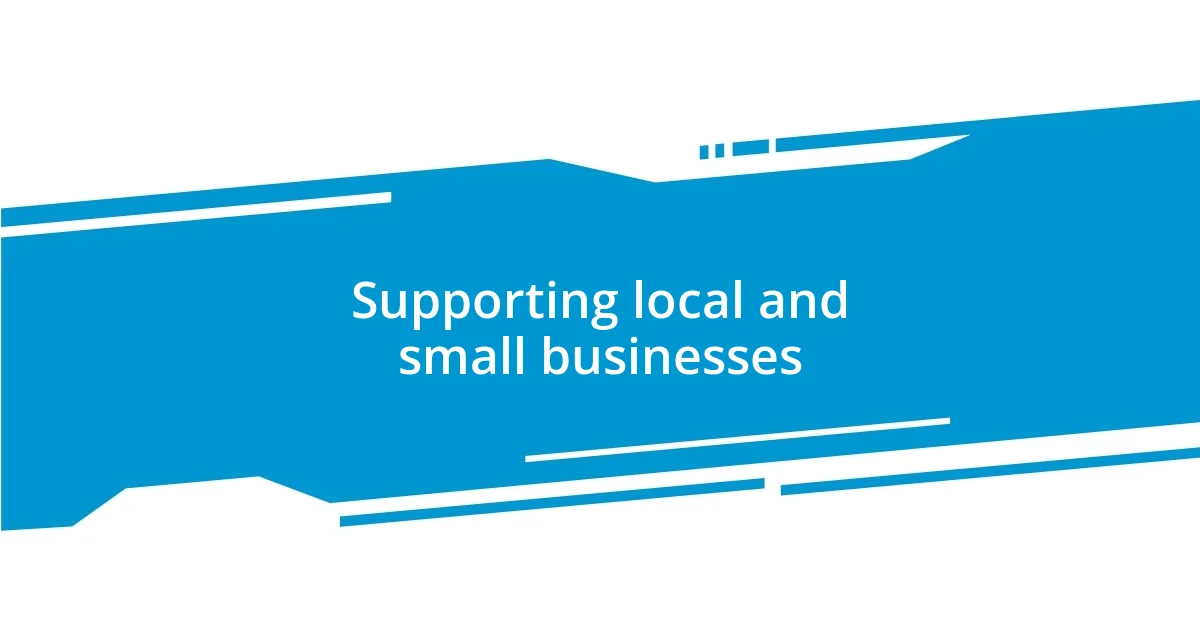Key takeaways:
- Slow fashion promotes sustainability, encouraging intentional purchasing and supporting local artisans to reduce waste and foster community connections.
- Ethical sourcing ensures fair labor practices and environmentally responsible materials, allowing consumers to make choices that reflect their values and support local economies.
- Building a lasting wardrobe focuses on quality, versatility, and creativity, transforming consumption into a mindful and fulfilling experience that embraces unique stories behind each piece.

Understanding slow fashion principles
Slow fashion principles center around sustainability and mindfulness in clothing production and consumption. When I first learned about this concept, it struck me how much waste modern fashion generates. Have you ever thought about the staggering amount of unwanted clothing that ends up in landfills? It’s a heartbreaking reality that many don’t realize.
At its core, slow fashion encourages thoughtful buying habits—prioritizing quality over quantity. I remember a time when I impulsively bought a cheap dress that fell apart after just a few wears. That taught me a valuable lesson: investing in durable, timeless pieces not only enhances your wardrobe but also contributes to environmental health.
Additionally, slow fashion embodies the idea of supporting local artisans and ethical labor practices. When I discovered a local maker who crafted beautiful, handmade garments, it ignited my passion for community-centered fashion. Doesn’t it feel good to know that your clothing is made with care and respect for people and the planet? It’s more than just clothing; it’s a statement about the values you hold dear.

Importance of ethical sourcing
Ethical sourcing is fundamental to the slow fashion movement, and for good reason. When businesses prioritize ethical sourcing, they ensure that the materials used come from responsible suppliers who treat their workers fairly and consider the environment. This resonates with me deeply, especially after visiting a textile factory that prioritized safe working conditions. Witnessing the workers’ pride in their craft made me realize just how interconnected our choices are with the realities of those who make our clothes.
Here are some critical points that highlight the importance of ethical sourcing:
- Fair Labor Practices: Workers should receive fair wages and safe working conditions, reflecting their dignity and rights.
- Environmental Responsibility: Ethical sourcing promotes sustainable materials, reducing harm to our planet.
- Supporting Local Economies: Purchasing from local artisans boosts communities and preserves traditional crafting methods.
- Transparency and Accountability: Consumers have the right to know where their clothing comes from, creating a culture of accountability in the fashion industry.
- Quality over Quantity: Understanding the source of materials often leads to better quality garments that last longer, reducing overall consumption.
When I consciously chosen to support a brand that embraced these principles, it felt like I was contributing to something larger than myself. I began to appreciate the stories behind each piece, leading me to a more fulfilling wardrobe that reflects my values. Isn’t it amazing how fashion can connect us to global communities in such a meaningful way?

Benefits of sustainable materials
Sustainable materials bring a multitude of benefits to both the environment and our personal choices as consumers. I remember the transformation in my wardrobe when I switched to organic cotton. The fabric felt softer against my skin, and knowing that it was grown without harmful pesticides made me feel good about my purchase. It’s striking to think that simple decisions like this can lead to reduced chemical exposure for farmers and a healthier ecosystem overall.
Moreover, using sustainably sourced materials often results in less energy consumption during production, which is something I find incredibly compelling. For instance, I recently invested in a pair of shoes made from recycled plastic bottles, and the difference was palpable—not only was I reducing waste, but the shoes were surprisingly breathable and comfortable. This realization reminded me that embracing sustainable options can lead to unexpectedly delightful experiences with products that are higher quality than their conventional counterparts.
Lastly, opting for sustainable materials fosters a deeper connection to the things we own. Every time I wear a jacket made from recycled wool, I am reminded of its story and the positive impacts of my purchase. Doesn’t it feel enriching to know your clothing doesn’t just serve a purpose, but also contributes to a larger cause? This kind of conscious consumption creates a fulfillment that fast fashion simply cannot match.
| Aspect | Conventional Materials | Sustainable Materials |
|---|---|---|
| Environmental Impact | High pollution, involves chemical processes | Lower pollution, eco-friendly practices |
| Worker Health | Often harmful chemicals and conditions | Safer, healthier alternatives for producers |
| Longevity | Frequently low quality and short lifespan | Durable, designed for longevity |
| Waste Reduction | Contributes to landfill issues | Promotes recycling and waste minimization |

Reducing consumption through mindful buying
Being mindful about what I buy has genuinely changed my approach to clothing. I vividly recall a time when I was shopping and stumbled upon a beautiful dress that I had an instant urge to buy. But instead of rushing to the checkout, I paused and asked myself if I truly needed it. That moment of reflection not only saved me money, but it also reinforced the idea that sometimes, less is more. Each purchase should be intentional, a decision that aligns with my values rather than an impulse driven by trends.
Incorporating mindful buying into my routine has fostered a sense of responsibility towards both my wardrobe and the environment. I recently stopped at a local boutique that sources its fabrics sustainably. Listening to the shopkeeper share the story behind the materials made me appreciate the process. It reminded me that each piece of clothing carries a narrative—one of craftsmanship, care, and thoughtfulness. Doesn’t it feel great to think we can wear something that has a purpose beyond just fashion?
When I commit to reducing consumption, I find myself gravitating toward quality over quantity. For instance, I still cherish a pair of jeans I purchased over three years ago—each wear only makes them softer. It strikes me that embracing a slower pace allows us to build a wardrobe filled with pieces that not only last but also tell a story. How often do we consider the long-term joy and value of our clothes rather than just the immediate satisfaction of a new buy?

Strategies for upcycling and recycling
Upcycling and recycling in fashion can offer incredible opportunities to transform what might seem like useless items into treasured pieces. I remember finding an old denim jacket in my closet that I hadn’t worn in years. Instead of discarding it, I decided to personalize it with fabric patches and some embellishments, turning it into a unique statement piece. The pride I felt wearing something I had creatively repurposed was uplifting—it’s like wearing my own story.
Another effective strategy is participating in clothing swaps with friends or local communities. I recently hosted one, and it felt like a mini fashion show! Everyone brought items they no longer loved, and we exchanged them with enthusiasm. It was heartwarming to see old clothes find new homes, and I cherished the new-to-me pieces I selected. Isn’t it wonderful how even a simple gathering can build connections and promote sustainability?
Finally, I often experiment with recycling fabric scraps from alterations or damaged garments. Recently, I turned some leftover cotton pieces into reusable shopping bags. Each time I use them, it reminds me of my commitment to reducing waste and embracing creativity. How many of us have old clothes lying around that could be transformed rather than tossed aside? With a little imagination, the possibilities are endless.

Building a lasting wardrobe
Building a lasting wardrobe is all about making intentional choices. I remember when I decided to invest in a high-quality coat instead of settling for a cheaper option. That coat has accompanied me through countless winter outings, and each time I wear it, I’m reminded of the warmth, both in fabric and in the memories made. Isn’t it amazing how a single piece can become a staple because of its quality and the stories it holds?
I also find great joy in curating a wardrobe that reflects my style over time. For example, I still wear a pair of boots that I bought over five years ago. They’ve aged gracefully, like fine wine, and they remind me of numerous adventures. The surprise for me was realizing how much more I appreciate these pieces that withstand the test of time compared to trend-driven items that soon lose their charm. And isn’t it satisfying to reach for something that feels like a reliable companion?
Lastly, I believe in the power of versatility when building a lasting wardrobe. I often choose pieces that can be styled in multiple ways. For instance, a simple black dress can transition from a day at the office to a night out with just a change of accessories. This approach not only maximizes my closet space but also opens up opportunities for creativity. How many ways can you style a favorite piece, and how does that enrich your personal expression?

Supporting local and small businesses
Supporting local and small businesses is one of the most rewarding aspects of embracing slow fashion. I still remember the excited feeling I had when I discovered a charming boutique in my neighborhood. The owner was so passionate about her craft, sharing stories about the artisans who created the pieces she sold. When I purchased a hand-knit scarf from her store, it felt special; it wasn’t just a transaction but a connection to the person who made it and the community we both belonged to.
In my experience, choosing to shop locally often leads to finding unique items that aren’t mass-produced. One winter, I stumbled upon a small leather workshop that crafted bags from sustainably sourced materials. I opted for a handcrafted messenger bag that not only met my practical needs but also carried an authenticity that mass-market options lack. Each time I use it, I think about the care that went into creating it, and it sparks conversations with others who admire its craftsmanship. Have you ever felt that strong connection to a piece because of its story?
Moreover, there’s a certain joy in knowing that my purchases are contributing to the local economy. I remember hearing about the impact that small businesses have on job creation and community vitality, and I wanted to be part of that positive change. I prioritize spending my money at farmer’s markets and local fashion shows, and every time I do, I can sense the energy and creativity that permeates these spaces. Supporting local businesses not only feeds my wardrobe with intentional pieces but also fills my heart with a sense of purpose—how rewarding is it to know that we’re helping our neighbors thrive?















